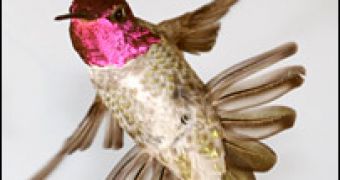We've known that the bird's trills are produced by a very complex organ called syrinx, located on their trachea. But a new research published in the "Proceedings of the Royal Society B" journal shows that in fact their chirps may be produced via the most unexpected means. A hummingbird species has been found to make its chirp sound by using its tail feathers.
Anna's hummingbirds (Calypte anna) is the northernmost species of hummingbird, the only one reaching Alaska. Some scientists said that the male emitted its calls using the throat, others that it did it via the tail, but now high-speed specialized footages solved the issue: the tail feathers of the male hummingbird vibrate during high-speed dives.
These vibrations produce a loud chirp while the male dives towards the ground at over 50mph (80km/h), during their attempts to seduce the females.
"Production of the sound was originally attributed to the tail, but a more recent study argued that the sound was vocal. We use high-speed video of diving birds, experimental manipulation on wild birds and laboratory experiments on individual feathers to show that the dive sound is made by tail feathers," wrote the authors, Chris Clarke and Teresa Feo from the University of California, Berkeley.
It appears that non-vocal or "mechanical" sounds are more common than previously believed in birds.
"A diverse array of birds apparently make mechanical sounds with their feathers. Few studies have established that these sounds are non-vocal, and the mechanics of how these sounds are produced remain poorly studied," wrote the authors.
"The footage revealed that the trailing vane of the birds' out-tail feathers fluttered rapidly to produce the sound. The characteristic dive caused a subtle change in the shape of these feathers to produce a loud chirping sound. Many kinds of birds are reported to create aerodynamic sounds with their wings or tail, and this model may explain a wide diversity of non-vocal sounds produced by birds," they added.

 14 DAY TRIAL //
14 DAY TRIAL //